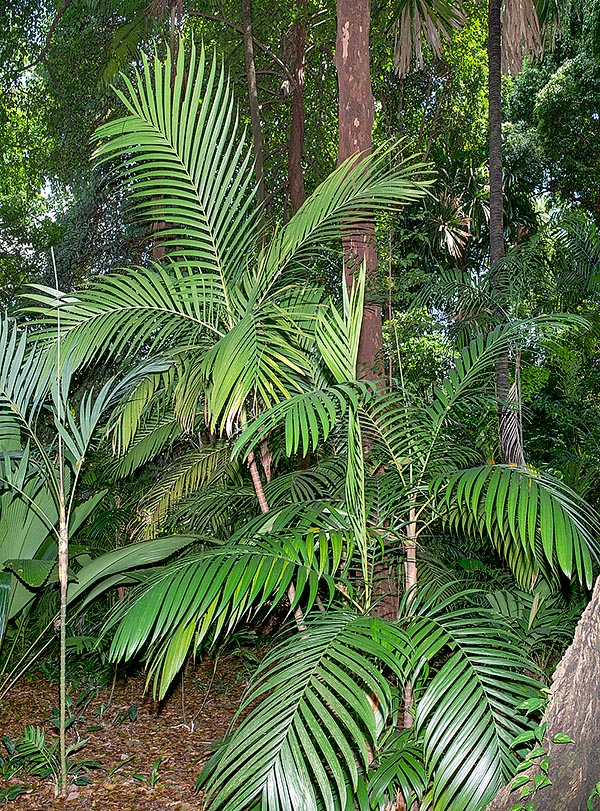Family : Arecaceae

Text © Pietro Puccio

English translation by Mario Beltramini

Originating from the rainforests and mangrove forests of Borneo, the splendid Nenga pumila var. pachystachya can grow 5 m high. Elegance and cultivation ease, even in pot © Giuseppe Mazza
The name of the genus comes from the Javanese one “nenge” or “niang-nieng”; the specific name is the Latin adjective “pumilus, a, um” = dwarf, that of the variety is the combination of the Greek adjective “παχύς” (pachýs) = big and of the substantive “στάχυς” (stáchys) = spike, with reference to the inflorescences.
Common names: pinang horaiung (Borneo); pinang muring (Peninsular Malaysia); pinang hutan, pinang unoo (Singapore); kajoe djambe (Sumatra); kache (Thailand).
The Nenga pumila var. pachystachya (Blume) Fernando (1983) is a cespitous monoecious palm, unarmed, with erect stems, 3-5 m tall and of 3-6 cm of diameter, of bright green colour in the younger parts, brown in the older ones, on which are evident the rings of the foliar scars spaced of about 10 cm; at times are present at the base stilty aerial roots. The leaves, on a 4-50 cm long petiole, are pinnate, up to about 2 m long, with linear or sigmoid leaflets with pointed apex arranged regularly on the rachis, up to 70 cm long and 2-3 cm broad in the median part, of bright intense green colour above, paler below.
The foliar base wraps entirely the stem, for a length of 35-60 cm, forming a sort of tubular capital with smooth surface of bright green to brown colour. Ramified inflorescences under the leaves (infrafoliar) usually drooping, with short peduncle and rachis and 2-4 rachillae, 20-45 cm long, bearing unisexual flowers arranged in triads (a female flower between two male ones), except in the terminal part where are present only male flowers. The flowers are dimorphic, the male triangular, with 9-13 mm long sepals and about 6 mm long petals, the female ones globose, with sepals and petals about 4 mm long. Oblong to ovoid-ellipsoid fruits, 2,4-3 cm long and of 1-1,5 cm of diameter, with prominent trilobed stigma, initially of green colour, then intense red and glossy when ripe, containing only one ovoid seed, 1-1,5 cm long and of about 0,8 cm of diameter, with pointed apex.
It distinguishes from the Nenga pumila (Blume) H.Wendl. (1878), native to Java, due to the fruits, that in the species are of red-orange colour and smaller, about 2 cm long and 0,9 cm of diameter, with circular stigma at the apex. It reproduces by seed, in draining loam rich of organic substance maintained humid at the temperature of 26-28 °C, with germination times of 2-3 months.
Very decorative species because of the elegant foliage and the showy infructescences, utilizable in parks and gardens, even of small dimensions, in the tropical and humid subtropical climate regions, its cultivation may be tried in the milder temperate-warm ones, where temperatures less than +10 °C are a short lasting exception, in sheltered and humid place. It requires preferably a slightly shaded position, even if it bears the full sun, and draining soils maintained constantly humid. Due to the reduced dimensions is also an excellent subject to cultivate in pot for the decoration of open spaces, where the climate allowes so, or winter gardens, verandahs and luminous interiors, in fertile loam with addition of sand or perlite per a 30%, with lowest winter temperatures not under the 16 °C. The waterings must be regular, in such way to maintain constantly humid the substratum, but without stagnations, and the fertilizations, from spring to autumn, done preferably with hydrosoluble products balanced with microelements.
Synonyms: Pinanga nenga var. pachystachya Blume (1839); Nenga intermedia Becc. (1885); Nenga schefferiana Becc. (1985); Nenga wendlandiana f. hexapetala Becc. (1889); Nenga wendlandiana var. malaccensis Becc. (1889).
→ For general notions about ARECACEAE please click here.
